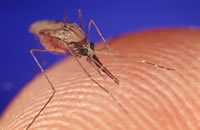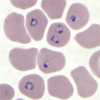Ecology of Malaria
Factors That Determine The Occurrence of Malaria
Factors that determine the occurrence of malaria are those that influence the three components of the malaria life cycle:
- Anopheles mosquitoes must be present, which are in contact with humans, and in which the parasites can complete the "invertebrate host" half of their life cycle
- Humans must be present, who are in contact with Anopheles mosquitoes, and in whom the parasites can complete the "vertebrate host" half of their life cycle
- Malaria parasites must be present.
Note:
In rare cases malaria parasites can be transmitted from one person to another without requiring passage through a mosquito (from mother to child in "congenital malaria" or through transfusion, organ transplantation, or shared needles.)
Climate
Climate can influence all three components of the life cycle. It is thus a key determinant in the geographic distribution and the seasonality of malaria.
Rainfall can create collections of water ("breeding sites") where Anopheles eggs are deposited, and larvae and pupae develop into adulthood, a process that takes approximately 9-12 days in tropical areas. Such breeding sites may dry up prematurely in the absence of further rainfall, or conversely they can be flushed and destroyed by excessive rains.
Once adult mosquitoes have emerged, the ambient temperature, humidity, and rains will determine their chances of survival. To transmit malaria successfully, female Anopheles must survive long enough after they have become infected (through a blood meal on an infected human) to allow the parasites they now harbor to complete their growth cycle ("extrinsic" cycle). That cycle takes 9-21 days at 25°C or 77°F. Warmer ambient temperatures shorten the duration of the extrinsic cycle, thus increasing the chances of transmission. Conversely, below a minimum ambient temperature (15°C or 59°F for Plasmodium vivax, 20°C or 68°F for P. falciparum), the extrinsic cycle cannot be completed and malaria cannot be transmitted. This explains in part why malaria transmission is greater in warmer areas of the globe (tropical and semitropical areas and lower altitudes), particularly for P. falciparum.
Climate also determines human behaviors that may increase contact with Anopheles mosquitoes between dusk and dawn, when the Anopheles are most active. Hot weather may encourage people to sleep outdoors or discourage them from using bed nets. During harvest seasons, agricultural workers might sleep in the fields or nearby locales, without protection against mosquito bites.
Anopheles Mosquitoes
The types (species) of Anopheles present in an area at a given time will influence the intensity of malaria transmission. Not all Anopheles are equally good "vectors" for transmitting malaria from one person to another. Some species are biologically unable to carry human malaria parasites, while others are readily infected and produce large numbers of sporozoites (the parasite stage that is infective to humans).
Different Anopheles species may differ in selected behavior traits, with important consequences on their abilities as malaria vectors. In some species the females prefer to get their blood meals from humans ("anthropophilic") while in others they prefer animals ("zoophilic"). Some species prefer to bite indoors ("endophagic"), and others prefer outdoor biting ("exophagic"). All other factors being equal, the anthropophilic, endophagic species will have more frequent contacts with humans and thus will be more effective malaria vectors.
Some species prefer to rest inside the dwellings where they have just obtained their blood meals ("endophilic") while others prefer to rest outdoors ("exophilic"). The endophilic species will be more likely to acquire lethal doses of insecticides sprayed on the walls of the dwellings (a malaria control measure called "indoor residual spraying") while this will not be the case for the exophilic species.

The anthropophilic Anopheles gambiae is an extremely effective vector and is one of the reasons why malaria is so prevalent in Africa.
An important biologic factor is insecticide resistance. If the mosquitoes are resistant to the insecticide(s) used locally for spraying or for treating bed nets, these measures will be ineffective in curtailing transmission.
More on: Anopheles Mosquitoes
Humans
Biologic characteristics (inborn and acquired) and behavioral traits can influence an individual's malaria risk and, on a larger scale, the overall malaria ecology.
More on: Human Factors And Malaria
Parasites
Characteristics of the malaria parasite can influence the occurrence of malaria and its impact on human populations:
- Areas where P. falciparum predominates (such as Africa south of the Sahara) will suffer more disease and death than areas where other species, which tend to cause less severe manifestations, predominate
- P. vivax and P. ovale have stages ("hypnozoites") that can remain dormant in the liver cells for extended periods of time (months to years) before reactivating and invading the blood. Such relapses can result in resumption of transmission after apparently successful control efforts, or can introduce malaria in an area that was malaria-free
- P. falciparum (and to a lesser extent P. vivax) have developed strains that are resistant to antimalarial drugs. Such strains are not uniformly distributed. Constant monitoring of the susceptibility of these two parasite species to drugs used locally is critical to ensure effective treatment and successful control efforts. Travelers to malaria-risk areas should use for prevention only those drugs that will be protective in the areas to be visited.

Plasmodium falciparum predominates in Africa south of the Sahara, one reason why malaria is so severe in that area.
Animal Reservoirs
A certain species of malaria called P. knowlesi has recently been recognized to be a cause of significant numbers of human infections. P. knowlesi is a species that naturally infects macaques living in Southeast Asia. Humans living in close proximity to populations of these macaques may be at risk of infection with this zoonotic parasite.
Areas Where Malaria Is No Longer Endemic
Malaria transmission has been eliminated in many countries of the world, including the United States. However, in many of these countries (including the United States) Anopheles mosquitoes are still present. Also, cases of malaria still occur in non-endemic countries, mostly in returning travelers or immigrants ("imported malaria"). Thus the potential for reintroduction of active transmission of malaria exists in many non-endemic parts of the world. All patients must be diagnosed and treated promptly for their own benefit but also to prevent the reintroduction of malaria.
- Page last reviewed: June 10, 2015
- Page last updated: June 10, 2015
- Content source:


 ShareCompartir
ShareCompartir